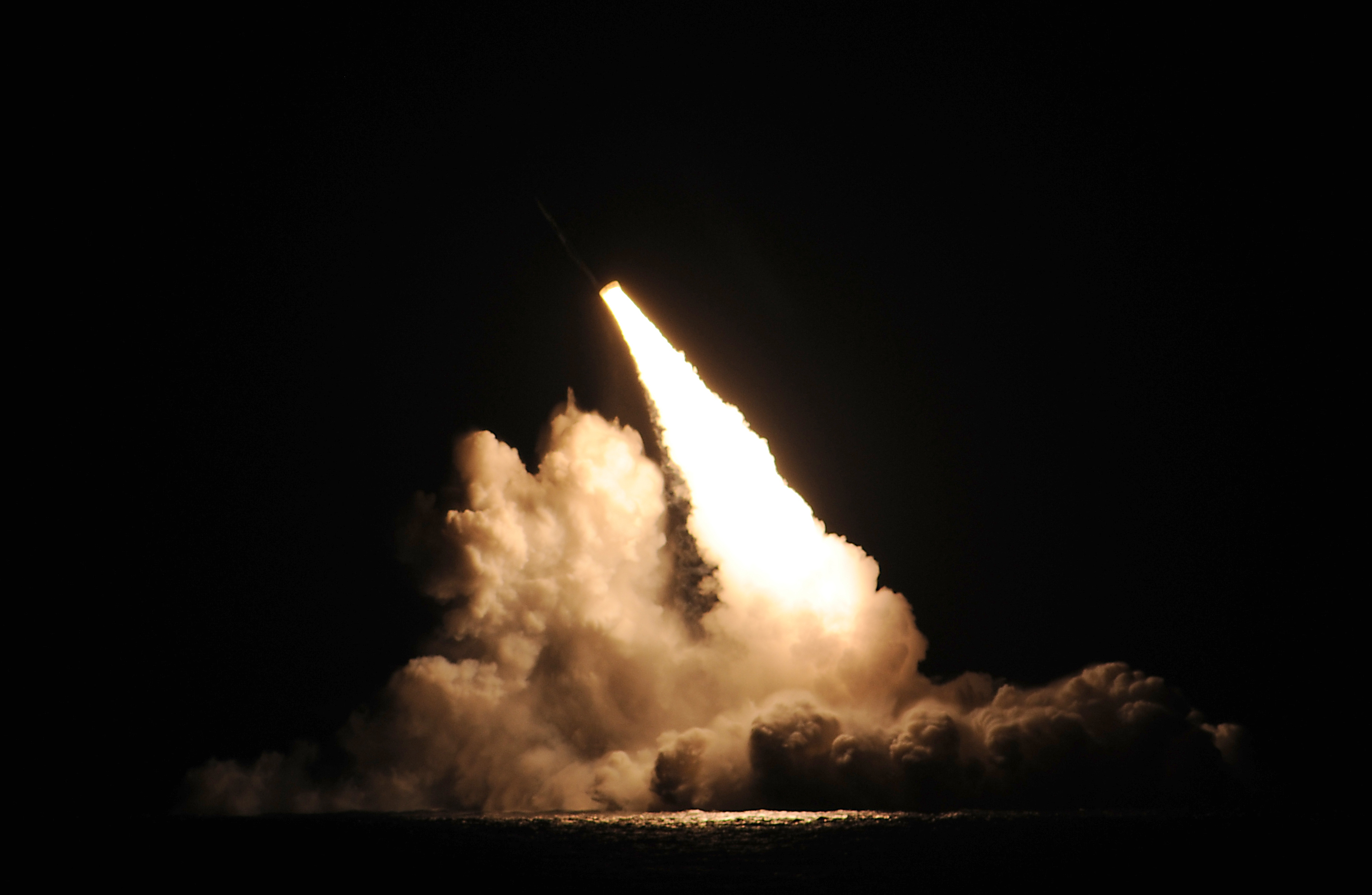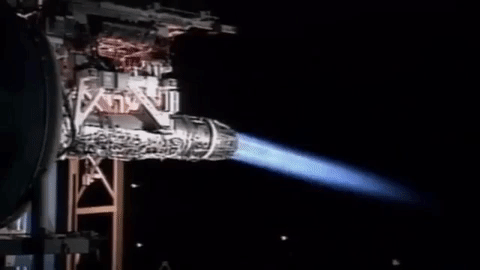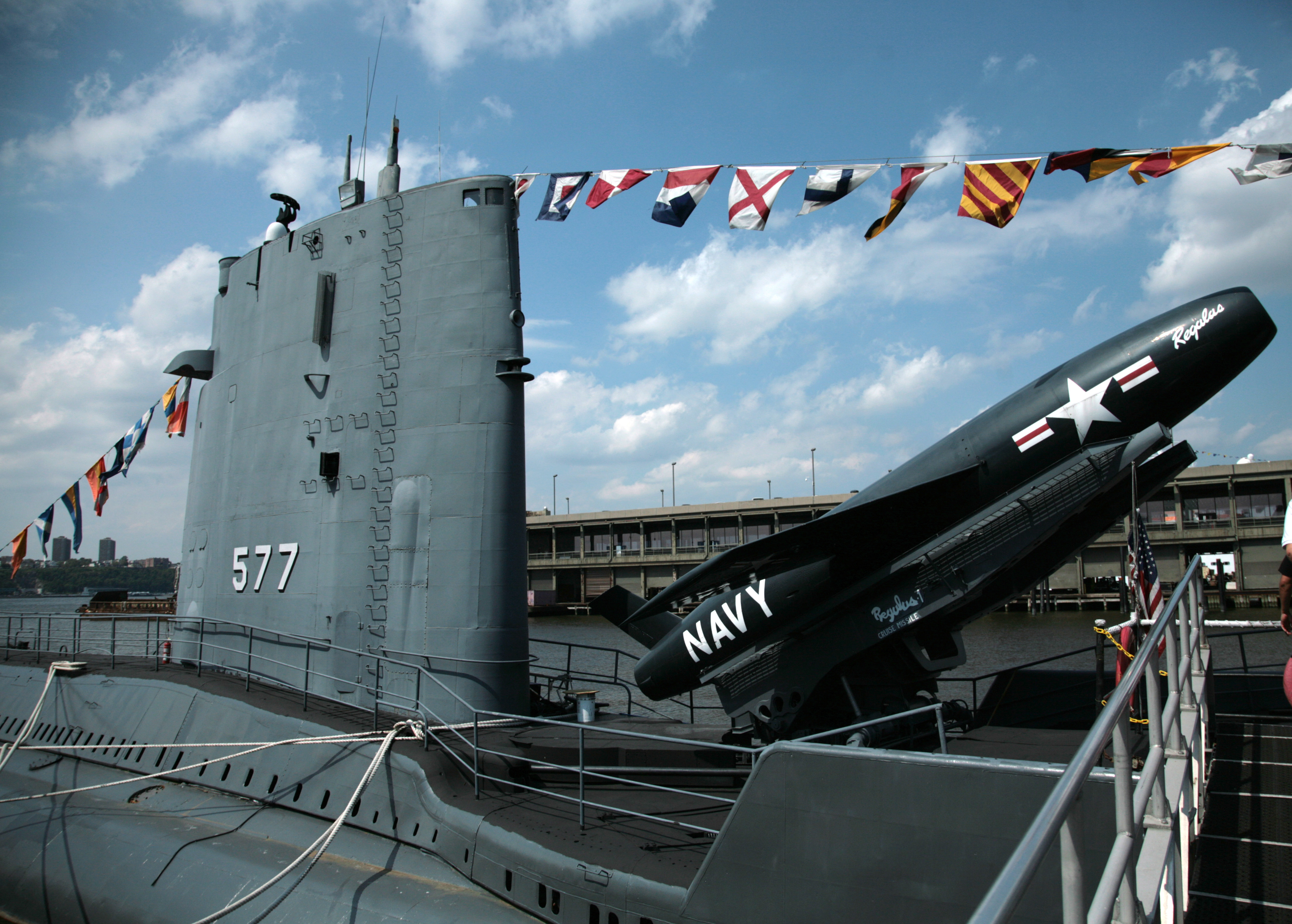|
UGM-133 Trident II
The UGM-133A Trident II, or Trident D5 is a submarine-launched ballistic missile (SLBM), built by Lockheed Martin Space in Sunnyvale, California, and deployed with the United States Navy and Royal Navy. It was first deployed in March 1990, and remains in service. The Trident II Strategic Weapons System is an improved SLBM with greater accuracy, payload, and range than the earlier Trident C-4. It is a key element of the U.S. strategic nuclear triad and strengthens U.S. strategic deterrence. The Trident II is considered to be a durable sea-based system capable of engaging many targets. It has payload flexibility that can accommodate various treaty requirements, such as New START. The Trident II's increased payload allows nuclear deterrence to be accomplished with fewer submarines, and its high accuracy—approaching that of land-based missiles—enables it to be used as a first strike weapon. Trident II missiles are carried by 14 US and 4 British submarines, with 24 missi ... [...More Info...] [...Related Items...] OR: [Wikipedia] [Google] [Baidu] |
Submarine-launched Ballistic Missile
A submarine-launched ballistic missile (SLBM) is a ballistic missile capable of being launched from Ballistic missile submarine, submarines. Modern variants usually deliver multiple independently targetable reentry vehicles (MIRVs), each of which carries a thermonuclear weapon, nuclear warhead and allows a single launched missile to strike several targets. Submarine-launched ballistic missiles operate in a different way from submarine-launched cruise missiles. Modern submarine-launched ballistic missiles are closely related to intercontinental ballistic missiles (ICBMs), with ranges of over , and in many cases SLBMs and ICBMs may be part of the same family of weapons. History Origins The first practical design of a submarine-based launch platform was developed by the Germans near the end of World War II involving a launch tube which contained a V-2 rocket, V-2 ballistic missile variant and was towed behind a submarine, known by the code-name V-2 rocket#Unfulfilled plans, ''Prüfs ... [...More Info...] [...Related Items...] OR: [Wikipedia] [Google] [Baidu] |
Thrust Vectoring
Thrust vectoring, also known as thrust vector control (TVC), is the ability of an aircraft, rocket or other vehicle to manipulate the direction of the thrust from its engine(s) or motor(s) to Aircraft flight control system, control the Spacecraft attitude control, attitude or angular velocity of the vehicle. In rocketry and ballistic missiles that fly outside the atmosphere, aerodynamic Flight control surfaces, control surfaces are ineffective, so thrust vectoring is the primary means of Flight dynamics (fixed-wing aircraft), attitude control. Exhaust vanes and Gimbaled thrust, gimbaled engines were used in the 1930s by Robert H. Goddard, Robert Goddard. For aircraft, the method was originally envisaged to provide upward vertical thrust as a means to give aircraft vertical (VTOL) or short (STOL) takeoff and landing ability. Subsequently, it was realized that using vectored thrust in combat situations enabled aircraft to perform various maneuvers not available to conventional-en ... [...More Info...] [...Related Items...] OR: [Wikipedia] [Google] [Baidu] |
Trident (missile)
The Trident missile is a submarine-launched ballistic missile (SLBM) equipped with multiple independently targetable reentry vehicles (MIRV). Originally developed by Lockheed Missiles and Space Corporation, the missile is armed with thermonuclear weapon, thermonuclear warheads and is launched from Nuclear submarine, nuclear-powered ballistic missile submarines (SSBNs). Trident missiles are carried by twelve United States Navy s, with American warheads, as well as four Royal Navy s, with British warheads. The missile is named after the mythological Trident of Poseidon, trident of Neptune. Development In 1971, the US Navy began studies of an advanced Undersea Long-range Missile System (ULMS). A Decision Coordinating Paper (DCP) for the ULMS was approved on 14 September 1971. ULMS program outlined a long-term modernization plan, which proposed the development of a longer-range missile termed ULMS II, which was to achieve twice the range of the existing Poseidon (ULMS I) missile. In ... [...More Info...] [...Related Items...] OR: [Wikipedia] [Google] [Baidu] |
New Strategic Arms Reduction Treaty
New START ( Russian abbrev.: СНВ-III, ''SNV-III'' from ''сокращение стратегических наступательных вооружений'' "reduction of strategic offensive arms") is a nuclear arms reduction treaty between the United States and the Russian Federation Russia, or the Russian Federation, is a country spanning Eastern Europe and North Asia. It is the list of countries and dependencies by area, largest country in the world, and extends across Time in Russia, eleven time zones, sharing Borders ... with the formal name of ''Measures for the Further Reduction and Limitation of Strategic Offensive Arms''. It was signed on 8 April 2010 in Prague, and after ratification it Entry into force, entered into force on 5 February 2011. New START replaced the Treaty of Moscow (SORT), which was to expire in December 2012. It follows the START I treaty, which expired in December 2009; the proposed START II treaty which never entered into force; and the ... [...More Info...] [...Related Items...] OR: [Wikipedia] [Google] [Baidu] |
Pre-emptive Nuclear Strike
In nuclear strategy, a first strike or preemptive strike is a preemptive surprise attack employing overwhelming force. First strike capability is a country's ability to defeat another nuclear power by destroying its arsenal to the point where the attacking country can survive the weakened retaliation while the opposing side is left unable to continue war. The preferred methodology is to attack the opponent's strategic nuclear weapon facilities (missile silos, submarine bases, bomber airfields), command and control sites, and storage depots first. The strategy is called counterforce. Historical background ''First-strike attack'', the use of a nuclear first strike capability, was greatly feared during the Cold War between NATO and the Soviet Bloc. At various points, fear of a first strike attack existed on both sides. Misunderstood changes in posture and well understood changes in technology used by either side often led to speculation regarding the enemy's intentions. 1948– ... [...More Info...] [...Related Items...] OR: [Wikipedia] [Google] [Baidu] |
Intercontinental Ballistic Missile
An intercontinental ballistic missile (ICBM) is a ballistic missile with a range (aeronautics), range greater than , primarily designed for nuclear weapons delivery (delivering one or more Thermonuclear weapon, thermonuclear warheads). Conventional weapon, Conventional, Chemical weapon, chemical, and Biological agent, biological weapons can also be delivered with varying effectiveness, but have never been deployed on ICBMs. Most modern designs support multiple independently targetable reentry vehicle (MIRVs), allowing a single missile to carry several warheads, each of which can strike a different target. The Nuclear weapons of the United States, United States, Russia and weapons of mass destruction, Russia, China and weapons of mass destruction, China, France and weapons of mass destruction, France, India and weapons of mass destruction, India, the United Kingdom and weapons of mass destruction, United Kingdom, Nuclear weapons and Israel, Israel, and North Korea and weapons of ... [...More Info...] [...Related Items...] OR: [Wikipedia] [Google] [Baidu] |
Submarine
A submarine (often shortened to sub) is a watercraft capable of independent operation underwater. (It differs from a submersible, which has more limited underwater capability.) The term "submarine" is also sometimes used historically or informally to refer to remotely operated vehicles and Autonomous underwater vehicle, robots, or to medium-sized or smaller vessels (such as the midget submarine and the wet sub). Submarines are referred to as ''boats'' rather than ''ships'' regardless of their size. Although experimental submarines had been built earlier, submarine design took off during the 19th century, and submarines were adopted by several navies. They were first used widely during World War I (1914–1918), and are now used in many navy, navies, large and small. Their military uses include: attacking enemy surface ships (merchant and military) or other submarines; aircraft carrier protection; Blockade runner, blockade running; Ballistic missile submarine, nuclear deterrenc ... [...More Info...] [...Related Items...] OR: [Wikipedia] [Google] [Baidu] |
New START
New START (Russian language, Russian abbrev.: СНВ-III, ''SNV-III'' from ''сокращение стратегических наступательных вооружений'' "reduction of strategic offensive arms") is a Nuclear disarmament, nuclear arms reduction treaty between the United States and the Russia, Russian Federation with the formal name of ''Measures for the Further Reduction and Limitation of Strategic Offensive Arms''. It was signed on 8 April 2010 in Prague, and after ratification it Entry into force, entered into force on 5 February 2011. New START replaced the Treaty of Moscow (SORT), which was to expire in December 2012. It follows the START I treaty, which expired in December 2009; the proposed START II treaty which never entered into force; and the START III treaty, for which negotiations were never concluded. The treaty calls for halving the number of Intercontinental ballistic missile, strategic nuclear missile launchers. A new inspection and verific ... [...More Info...] [...Related Items...] OR: [Wikipedia] [Google] [Baidu] |
Deterrence Theory
Deterrence theory refers to the scholarship and practice of how threats of using force by one party can convince another party to refrain from initiating some other course of action. The topic gained increased prominence as a military strategy during the Cold War with regard to the use of nuclear weapons and is related to but distinct from the concept of mutual assured destruction, according to which a full-scale nuclear attack on a power with second-strike capability would devastate both parties. The central problem of deterrence revolves around how to credibly threaten military action or nuclear punishment on the adversary despite its costs to the deterrer. Deterrence in an international relations context is the application of deterrence theory to avoid conflict. Deterrence is widely defined as any use of threats (implicit or explicit) or limited force intended to dissuade an actor from taking an action (i.e. maintain the status quo). Deterrence is unlike compellence, which ... [...More Info...] [...Related Items...] OR: [Wikipedia] [Google] [Baidu] |
Nuclear Triad
A nuclear triad is a three-pronged military force structure of land-based intercontinental ballistic missiles (ICBMs), submarine-launched ballistic missiles (SLBMs), and strategic bombers with Nuclear weapon, nuclear bombs and missiles. Countries build nuclear triads to eliminate an enemy's ability to destroy a nation's nuclear forces in a Pre-emptive nuclear strike, first-strike attack, which preserves their own ability to launch a second strike and therefore increases their nuclear deterrence. Four countries are known to have complete nuclear triad: United States, the United States, Russia, India, and China. Israel is suspected to possess a nuclear triad, but its status is not confirmed. France and Pakistan are considered partial triad powers. Components of a strategic nuclear triad While traditional nuclear strategy holds that a nuclear triad provides the best level of deterrence from attack, most nuclear powers do not have the military budget to sustain a full triad. The on ... [...More Info...] [...Related Items...] OR: [Wikipedia] [Google] [Baidu] |
UGM-96 Trident I
The UGM-96 Trident I, or Trident C4, was an American submarine-launched ballistic missile (SLBM), built by Lockheed Martin Space Systems in Sunnyvale, California. First deployed in 1979, the Trident I replaced the Poseidon missile. It was retired in 2005, having been replaced by the Trident II. The missile was a three-stage, solid-fuelled system, capable of carrying up to eight W76 warheads in the Mark 4 RB. The first eight s were armed with Trident I missiles. Twelve - and s were also retrofitted with Trident I missiles, which replaced older Poseidon missiles. In 1980, the Royal Navy requested Trident I missiles under the Polaris Sales Agreement. In 1982, the agreement was changed to supply Trident II instead. See also * Trident (missile) * UGM-133 Trident II The UGM-133A Trident II, or Trident D5 is a submarine-launched ballistic missile (SLBM), built by Lockheed Martin Space in Sunnyvale, California, and deployed with the United States Navy and Royal Navy. It was f ... [...More Info...] [...Related Items...] OR: [Wikipedia] [Google] [Baidu] |
US Navy
The United States Navy (USN) is the naval warfare, maritime military branch, service branch of the United States Department of Defense. It is the world's most powerful navy with the largest Displacement (ship), displacement, at 4.5 million tons in 2021. It has the world's largest aircraft carrier fleet, with List of aircraft carriers in service, eleven in service, one undergoing trials, two new carriers under construction, and six other carriers planned as of 2024. With 336,978 personnel on active duty and 101,583 in the Ready Reserve, the U.S. Navy is the third largest of the United States military service branches in terms of personnel. It has 299 deployable combat vessels and about 4,012 operational aircraft as of 18 July 2023. The U.S. Navy is one of six United States Armed Forces, armed forces of the United States and one of eight uniformed services of the United States. The United States Navy traces its origins to the Continental Navy, which was established during ... [...More Info...] [...Related Items...] OR: [Wikipedia] [Google] [Baidu] |








